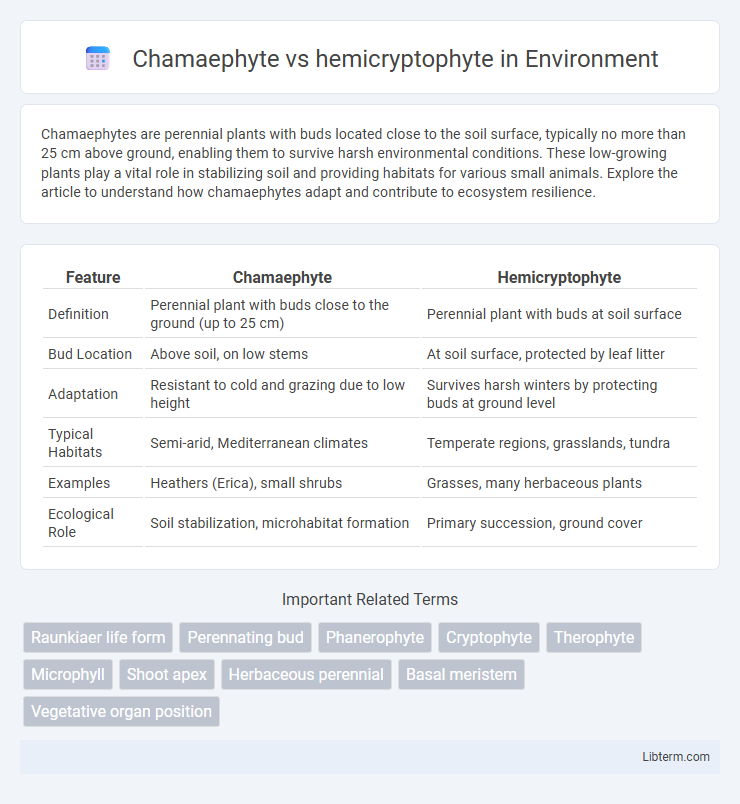Chamaephytes are perennial plants with buds located close to the soil surface, typically no more than 25 cm above ground, enabling them to survive harsh environmental conditions. These low-growing plants play a vital role in stabilizing soil and providing habitats for various small animals. Explore the article to understand how chamaephytes adapt and contribute to ecosystem resilience.
Table of Comparison
| Feature | Chamaephyte | Hemicryptophyte |
|---|---|---|
| Definition | Perennial plant with buds close to the ground (up to 25 cm) | Perennial plant with buds at soil surface |
| Bud Location | Above soil, on low stems | At soil surface, protected by leaf litter |
| Adaptation | Resistant to cold and grazing due to low height | Survives harsh winters by protecting buds at ground level |
| Typical Habitats | Semi-arid, Mediterranean climates | Temperate regions, grasslands, tundra |
| Examples | Heathers (Erica), small shrubs | Grasses, many herbaceous plants |
| Ecological Role | Soil stabilization, microhabitat formation | Primary succession, ground cover |
Introduction to Plant Life Forms
Chamaephytes are perennial plants with buds located close to the ground, typically less than 25 cm above soil, allowing them to survive adverse environmental conditions by protecting their growing points. Hemicryptophytes possess buds at the soil surface, often insulated by leaf litter or snow, facilitating regeneration after periods of dormancy or stress. Both life forms are crucial in understanding plant adaptation strategies in diverse climates and play significant roles in ecological succession and vegetation dynamics.
Defining Chamaephytes: Characteristics and Examples
Chamaephytes are perennial plants characterized by their buds located close to the ground, typically less than 25 centimeters above the soil surface, which helps them survive adverse conditions such as frost or grazing. These plants often exhibit woody stems and include examples such as heather (Calluna vulgaris) and dwarf shrubs like Juniperus communis. In contrast to hemicryptophytes, whose buds are at soil level, chamaephytes' elevated bud position provides a distinct strategy for environmental adaptation.
Understanding Hemicryptophytes: Key Features
Hemicryptophytes are perennial plants characterized by their buds positioned at the soil surface, enabling survival through harsh seasons and allowing regrowth during favorable conditions. These plants often have adaptations such as rosette leaves or protective coverings to shield their meristems from environmental stress. Unlike chamaephytes, whose buds are elevated above the ground on persistent shoots, hemicryptophytes maintain their growth points at or just below soil level, optimizing resilience and energy conservation.
Ecological Distribution: Chamaephytes vs Hemicryptophytes
Chamaephytes, with their buds positioned close to the ground, predominantly thrive in arid and cold environments where protection from extreme weather is crucial, often dominating alpine and tundra ecosystems. Hemicryptophytes, characterized by buds at soil level, exhibit a wider ecological distribution, commonly found in temperate grasslands, meadows, and forest understoreys due to their adaptation to periodic disturbances like grazing and seasonal temperature variations. The distinct vertical positioning of buds in chamaephytes and hemicryptophytes influences their survival strategies and distribution patterns across different biomes.
Adaptations to Environment
Chamaephytes possess buds close to the ground, enabling survival in harsh climates by protecting meristems from frost and desiccation, making them well-adapted to cold or dry environments. Hemicryptophytes have buds situated at the soil surface, allowing them to endure seasonal changes by retreating underground during unfavorable conditions and resprouting when favorable conditions return. These distinct bud placement strategies optimize survival and regrowth in variable climates and contribute to each life form's ecological success.
Comparative Morphology
Chamaephytes possess buds located just above the soil surface, typically on woody stems or low shrubs, providing increased protection from cold and herbivory, whereas hemicryptophytes have buds at the soil surface often shielded by leaf litter or snow cover. Morphologically, chamaephytes exhibit persistent woody structures that support perennial shoots above ground, while hemicryptophytes generally have herbaceous shoots that die back annually with buds at ground level. These structural differences influence their ecological adaptations and survival strategies in varying climates and habitats.
Roles in Ecosystems
Chamaephytes, with their buds close to the ground, play crucial roles in stabilizing soil and providing microhabitats for invertebrates and small animals in harsh environments. Hemicryptophytes, having buds at soil level, contribute significantly to ecosystem recovery by storing energy reserves and promoting regrowth after disturbances like fire or frost. Both life-forms enhance biodiversity and nutrient cycling, supporting resilient plant communities in temperate and alpine ecosystems.
Climate Tolerance and Survival Strategies
Chamaephytes, with perennating buds located close to the soil surface, exhibit strong resilience to harsh climates by minimizing exposure to extreme temperatures and desiccation, making them well-suited for arid and alpine environments. Hemicryptophytes, whose buds are situated at ground level and often protected by soil or leaf litter, demonstrate adaptability to temperate climates with seasonal variations by surviving cold winters and resprouting in favorable conditions. Both life forms employ survival strategies such as bud protection and dormancy, enhancing their tolerance to climatic stresses through structural and physiological adaptations.
Importance in Vegetation Classification
Chamaephytes and hemicryptophytes are crucial life forms in vegetation classification, representing different survival strategies in response to environmental conditions. Chamaephytes, with their perennating buds close to the ground, are vital indicators of harsh climates and exposure, often dominating tundra and alpine regions. Hemicryptophytes, having buds at soil surface level, play a key role in temperate grasslands and deciduous forests, reflecting adaptations to seasonal disturbances and grazing pressures.
Conclusion: Chamaephytes and Hemicryptophytes in Perspective
Chamaephytes and hemicryptophytes represent distinct survival strategies adapted to varying environmental conditions, with chamaephytes typically having buds close to the ground, offering protection from harsh climates, and hemicryptophytes possessing buds at soil level, enhancing resilience during seasonal changes. Their distribution reflects evolutionary adaptations, with chamaephytes prevalent in alpine and arid regions, while hemicryptophytes dominate temperate zones. Understanding these life-form strategies provides critical insights into plant ecology, succession, and habitat-specific adaptations.
Chamaephyte Infographic

 libterm.com
libterm.com